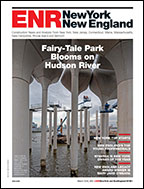The possibility of a cable-stayed bridge became apparent at a Dec. 6 briefing for stakeholders in Nyack, N.Y., where representatives of the New York State Dept. of Transportation, which recently took over the leadership of the project, the New York State Thruway Authority and Metro North Railroad, told civic leaders, preservationists and others that all options are being considered. Mark Roche, an associate of Arup, the bridge engineers working for the Thruway Authority, also said he is agnostic on the issue of bridge type.
Officially, the three transportation agencies unveiled recommendations that will be refined after community input and submitted for environmental review. In addition to eliminating tunnels, the three agencies dropped the idea for a light-rail spur on the western, or Rockland County, side of the span but continue to consider a plan for the new bridge to contain a commuter-rail line. It would connect with the regions existing network and a light-rail line from Tarrytown on the eastern, or Westchester County, side to Port Chester, N.Y.
The main goal is to alleviate traffic that is choking the entire I-287 corridor and the deteriorated 50-year-old causeway and truss structure. Possibilities include high occupancy lanes and a new intermodal connection near Tarrytown.
Planning will take another five years and construction five more, estimates Michael Anderson of the Dept. of Transportation.
A cable-stayed structure is increasingly likely for several reasons. Adequate anchorages are lacking for a suspension bridge, notes Neal H. Bettigole, a Saddle River, N.J.-based engineer. And Hudson River Valley residents and political leaders are calling for a beautiful bridge. "Esthetics are important," says Orangetown Supervisor Thom Kleiner. A truss bridge not only is hard to maintain, says one engineer working on the project, "Its out of the question because it wont be beautiful."
hree key transportation agencies in the planning behind a possible replacement for the Tappan Zee Bridge across the Hudson River north of New York City say they have eliminated tunnels as an option, increasing the likelihood that a new bridge will be built. A cable-stayed bridge has the greatest potential of being built, suggest engineers involved in and observing the planning process.


